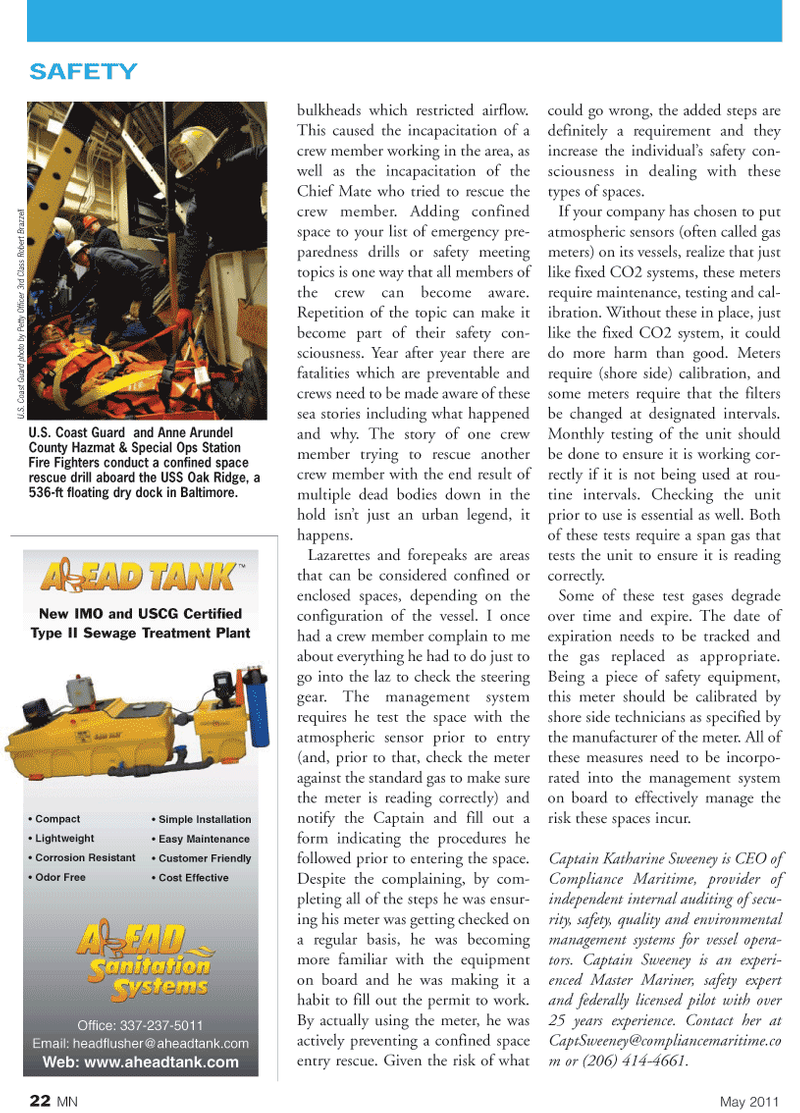
Page 22: of Marine News Magazine (May 2011)
Combat Craft Annual
Read this page in Pdf, Flash or Html5 edition of May 2011 Marine News Magazine
bulkheads which restricted airflow.
This caused the incapacitation of a crew member working in the area, as well as the incapacitation of the
Chief Mate who tried to rescue the crew member. Adding confined space to your list of emergency pre- paredness drills or safety meeting topics is one way that all members of the crew can become aware.
Repetition of the topic can make it become part of their safety con- sciousness. Year after year there are fatalities which are preventable and crews need to be made aware of these sea stories including what happened and why. The story of one crew member trying to rescue another crew member with the end result of multiple dead bodies down in the hold isn’t just an urban legend, it happens.
Lazarettes and forepeaks are areas that can be considered confined or enclosed spaces, depending on the configuration of the vessel. I once had a crew member complain to me about everything he had to do just to go into the laz to check the steering gear. The management system requires he test the space with the atmospheric sensor prior to entry (and, prior to that, check the meter against the standard gas to make sure the meter is reading correctly) and notify the Captain and fill out a form indicating the procedures he followed prior to entering the space.
Despite the complaining, by com- pleting all of the steps he was ensur- ing his meter was getting checked on a regular basis, he was becoming more familiar with the equipment on board and he was making it a habit to fill out the permit to work.
By actually using the meter, he was actively preventing a confined space entry rescue. Given the risk of what could go wrong, the added steps are definitely a requirement and they increase the individual’s safety con- sciousness in dealing with these types of spaces.
If your company has chosen to put atmospheric sensors (often called gas meters) on its vessels, realize that just like fixed CO2 systems, these meters require maintenance, testing and cal- ibration. Without these in place, just like the fixed CO2 system, it could do more harm than good. Meters require (shore side) calibration, and some meters require that the filters be changed at designated intervals.
Monthly testing of the unit should be done to ensure it is working cor- rectly if it is not being used at rou- tine intervals. Checking the unit prior to use is essential as well. Both of these tests require a span gas that tests the unit to ensure it is reading correctly.
Some of these test gases degrade over time and expire. The date of expiration needs to be tracked and the gas replaced as appropriate.
Being a piece of safety equipment, this meter should be calibrated by shore side technicians as specified by the manufacturer of the meter. All of these measures need to be incorpo- rated into the management system on board to effectively manage the risk these spaces incur.
Captain Katharine Sweeney is CEO of
Compliance Maritime, provider of independent internal auditing of secu- rity, safety, quality and environmental management systems for vessel opera- tors. Captain Sweeney is an experi- enced Master Mariner, safety expert and federally licensed pilot with over 25 years experience. Contact her at
[email protected] m or (206) 414-4661. 22 MN May 2011
Office: 337-237-5011
Email: [email protected]
Web: www.aheadtank.com
New IMO and USCG Certified
Type II Sewage Treatment Plant • Compact • Lightweight • Corrosion Resistant • Odor Free • Simple Installation • Easy Maintenance • Customer Friendly • Cost Effective
SAFETY
U.S. Coast Guard and Anne Arundel
County Hazmat & Special Ops Station
Fire Fighters conduct a confined space rescue drill aboard the USS Oak Ridge, a 536-ft floating dry dock in Baltimore.
U.S. Coast Guar d photo by Petty Of ficer 3r d Class Rober t Brazzell

 21
21

 23
23
